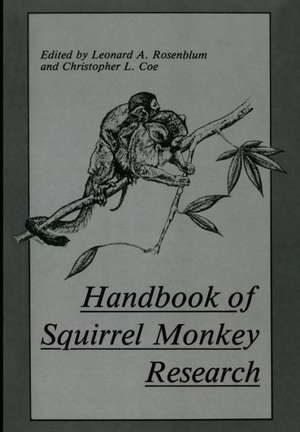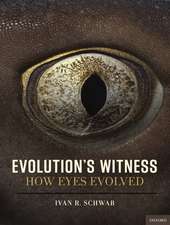Handbook of Squirrel Monkey Research
Editat de C.L. Coe, Leonard A. Rosenblumen Limba Engleză Paperback – 25 noi 2012
Preț: 958.73 lei
Preț vechi: 1169.19 lei
-18% Nou
Puncte Express: 1438
Preț estimativ în valută:
183.44€ • 192.56$ • 152.27£
183.44€ • 192.56$ • 152.27£
Carte tipărită la comandă
Livrare economică 11-25 aprilie
Preluare comenzi: 021 569.72.76
Specificații
ISBN-13: 9781475708141
ISBN-10: 1475708149
Pagini: 524
Ilustrații: XXI, 501 p. 223 illus.
Greutate: 0.83 kg
Ediția:Softcover reprint of the original 1st ed. 1985
Editura: Springer Us
Colecția Springer
Locul publicării:New York, NY, United States
ISBN-10: 1475708149
Pagini: 524
Ilustrații: XXI, 501 p. 223 illus.
Greutate: 0.83 kg
Ediția:Softcover reprint of the original 1st ed. 1985
Editura: Springer Us
Colecția Springer
Locul publicării:New York, NY, United States
Public țintă
ResearchDescriere
As the editors of the first book on the squirrel monkey prophesied in 1968,* there has been an incredible expansion in primate research during the past 16 years. Their projection that the squirrel monkey would play an increasingly important role in this research effort has also come to be true during the ensuing years. One inadvertent result of the rapid growth, however, is that it has become more and more difficult for investigators to keep track of new information, both in their own disciplines and in related fields. For scientists who study and use the squirrel monkey in research, this problem is particularly pronounced, because articles are often published in specialized and disparate journals. We felt that a new synthesis of the vast amount of information on Saimiri would resolve this problem and would provide an extremely valuable com panion volume to the first book. The idea grew out of a small symposium held at the IX Congress of the International Primatological Society in Atlanta, Geor gia, during August, 1982. Following the format of The Squirrel Monkey, ad ditional authors were invited to discuss advances in areas which had experi enced exceptional growth or to review basic information that would be of practical value to future researchers. Even with focused topics and synthetic reviews, the wealth of new data resulted in many long manuscripts. In response to the continuing problems with Saimiri nomenclature, Richard Thorington has provided us with a definitive statement on squirrel monkey taxonomy.
Cuprins
1 The Taxonomy and Distribution of Squirrel Monkeys (Saimiri).- 1. Introduction.- 2. Methodology.- 3. Methods.- 4. Results.- 4.1. Saimiri sciureus sciureus.- 4.2. Saimiri sciureus boliviensis.- 4.3. Saimiri sciureus cassiquiarensis.- 4.4. Saimiri sciureus oerstedii.- 4.5. Saimiri madeirae.- 5. Discussion.- Appendix 1. Taxonomic Borborygme.- Appendix 2. Specimens Examined.- References.- 2 The Behavior of Squirrel Monkeys (Saimiri) in Natural Environments.- 1. Introduction.- 2. Specializations.- 2.1. Diet.- 2.2. Locomotion.- 2.3. Habitat.- 3. Activity Pattern.- 4. Group Size.- 5. Home Range.- 6. Social Behavior and Organization.- 6.1. Mating Activities.- 6.2. Birth Season.- 6.3. After Birth Season.- 6.4. Juveniles.- 6.5. Sexual Maturation.- 6.6. Communication.- 7. Relations with Other Species.- References.- 3 Cognition in Squirrel Monkeys: A Contemporary Perspective.- 1. Introduction.- 2. Sensory, Motor, and Cognitive Attributes Underlying Behavior.- 2.1. Vision and Looking Behavior.- 2.2. Attention.- 2.3. Habituation and Sensitization.- 2.4. Memory.- 2.5. Response to Novelty (Curiosity).- 2.6. Tempo of Motor Activity.- 2.7. Vigor and Frequency of Motor Activity.- 2.8. Variability of Motor Activity.- 2.9. A Heuristic Approach to Interspecific Comparisons of Cognitive and Sensorimotor Attributes.- 3. Performance on Selected Laboratory Tasks.- 3.1. Discrimination and Discrimination-Reversal.- 3.2. Concept Learning.- 3.3. Problem-Solving.- 4. Expression of Cognitive and Sensorimotor Characteristics in Everyday Behavior.- 4.1. Use of Space.- 4.2. Feeding and Activity Patterns.- 4.3. Group Cohesion and Dispersion.- 5. Topics for Future Research.- 6. Conclusion.- References.- 4 Squirrel Monkey Communication.- 1. Introduction.- 2. Overview of the Vocal Repertoire.- 2.1. Previous Studies of the Squirrel Monkey Vocal Repertoire.- 2.2. Major Functional Classes of Vocalizations.- 2.3. Infant Vocalizations.- 3. Inherited and Experiential Influences on Squirrel Monkey Vocalization.- 3.1. Introduction.- 3.2. Inherited Characteristics of the Squirrel Monkey Isolation Call.- 4. Visual Displays.- 4.1. Introduction.- 4.2. Facial Expressions.- 5. Olfactory Communication.- 6. Conclusion.- References.- 5 Physiological Consequences of Maternal Separation and Loss in the Squirrel Monkey.- 1. Introduction.- 2. Normal Development and Basic Separation Procedures.- 3. Adrenal Responses to Maternal Separation.- 4. Effect of Environmental Conditions and Social Support.- 5. Effect of Repeated Separation Experiences.- 6. Importance of Adrenal Activation during Separation.- 7. Effect of Separation on the Immune System.- 8. Neurotransmitter Activity during Separation.- 9. General Considerations.- References.- 6 Effects of Surrogate-Rearing on the Infant Squirrel Monkey.- 1. Introduction.- 2. Responsiveness to the Surrogate.- 3. Responses to Separation and Novelty.- 4. Social Behavior.- 5. Atypical Behaviors.- 6. Summary of Comparisons with Macaques.- References.- 7 Reproductive Cyclicity and Breeding in the Squirrel Monkey.- 1. Introduction.- 2. The Reproductive Cycle.- 2.1. Cycle Length.- 2.2. Cycle Endocrinology.- 2.3. Seasonal Influences and Captivity Adaptation.- 3. Ovulation and Fertilization.- 3.1. Normal Follicular Morphology.- 3.2. Ovulation Induction.- 3.3. Fertilization.- 4. Captivity Breeding and Artificial Insemination.- 5. Pregnancy.- 5.1. Diagnosis.- 5.2. Gestation Length.- 5.3. Time of Implantation.- 5.4. Placental Physiology.- 5.5. Stillbirth and Abortion.- 6. Embryonic Development.- 7. Pregnancy Outcome.- 8. Summary.- References.- 8 The Endocrine System of the Squirrel Monkey.- 1. Introduction.- 2. Hormone Profile.- 3. Annual Reproductive Pattern.- 4. Diurnal Hormone Rhythm.- 5. Hormone Changes at Puberty.- 6. Effect of Body Weight.- 7. Hormone Differences in Saimiri Females.- 8. Psychological Influences on Hormone Secretion.- 9. General Considerations.- References.- 9 Thermoregulation in the Squirrel Monkey.- 1. Basic Concepts.- 2. Autonomic Thermoregulatory Responses.- 2.1. Method of Partitional Calorimetry.- 2.2. Stitt and Hardy’s Experiment.- 2.3. Basic Data on Autonomic Thermoregulation.- 2.4. Probing Autonomic Capabilities with Thermodes.- 2.5. Autonomic Thermoregulation during Fever.- 2.6. Effects of CNS Lesions and Chemical Agents Other Than Pyrogens.- 2.7. Circadian Variations in Body Temperature.- 2.8. Autonomic Thermoregulation during Exposure to Microwave Fields.- 3. Behavioral Thermoregulation.- 3.1. Natural (Instinctive) Thermoregulatory Behaviors.- 3.2. Operant Control of the Thermal Environment.- 3.3. Probing Changes in Thermoregulatory Behavior with Thermodes.- 3.4. Important Parameters of Central Thermal Stimulation.- 3.5. Interaction between Behavioral and Autonomic Thermoregulatory Responses.- References.- 10 Sneezing Behavior in the Squirrel Monkey and Its Biological Significance.- 1. Introduction.- 2. Sneezing Behaviors: A Closer Look.- 3. On Functions and Effects.- 4. Sneezing Behaviors: What Function?.- 5. The Hypotheses on Trial.- 6. Sneezing: Functional Aspects.- 7. Epilogue.- References.- 11 Visual System of the Squirrel Monkey.- 1. Introduction.- 2. Organization of the Visual System.- 2.1. The Eye.- 2.2. Subcortical Visual Centers.- 2.3. Visual Cortex.- 3. Visual Capacities.- 3.1. Some Practical Issues.- 3.2. Visual Sensitivity.- 3.3. Color Vision.- 3.4. Spatial Vision.- 3.5. Binocular Vision.- References.- 12 Use of Squirrel Monkeys in Cardiovascular Research.- 1. Introduction.- 2. Naturally Occurring Atherosclerosis.- 2.1. Early Reports.- 2.2. Leticia, Colombia Study 1967.- 2.3. Squirrel Monkeys Compared to Other New World Monkeys.- 2.4. Histological Characteristics.- 3. Dietary Effects on Atherosclerosis.- 3.1. Summary of Lipid Changes.- 3.2. Composition of Diet.- 3.3. Type of Dietary Fat.- 3.4. Genetic Influences on Diet-Induced Atherosclerosis.- 4. Additional Effects on Diet-Induced Atherosclerosis.- 4.1. Effects of Age and Sex.- 4.2. Effects of Hypothyroidism, Insulin Deficiency, and Renally Induced Hypertension.- 4.3. Effects of Psychic Stress.- 5. Summary of Lesions and Complications of Atherosclerosis.- 5.1. Summary of Lesions by Location.- 5.2. Congestive Heart Failure.- 5.3. Myocardial Infarction.- 5.4. Aneurysms.- 5.5. Regression of Diet-Induced Atherosclerosis.- 6. Stress-Induced Cardiomyopathy.- 7. Behaviorally Induced Hypertension.- 8. Diseases Complicating the Use of Squirrel Monkeys in Cardiovascular Research.- 8.1. Cholelithiasis.- 8.2. Glomerulonephritis.- 8.3. Aortitis.- 8.4. Trypanosomiasis.- 9. Conclusion.- References.- 13 Behavioral Pharmacology of the Squirrel Monkey.- 1. Introduction: Procedures in Behavioral Pharmacology.- 1.1. Behavioral Pharmacology.- 1.2. Schedule-Controlled Behavior.- 1.3. Schedules Using Behavior Maintained by Food Presentation or Drug Injection.- 1.4. Schedules Using Noxious Stimuli.- 2. Determinants of the Behavioral Effects of Drugs.- 2.1. Response Rate.- 2.2. Behavioral and Pharmacological History.- 2.3. Nature of the Maintaining Event.- 2.4. Environmental Context.- 3. Behavioral Effects of Drugs in the Squirrel Monkey.- 3.1. Psychomotor Stimulants.- 3.2. Antianxiety Drugs, Sedative-Hypnotics, and Serotonin Antagonists.- 3.3. Antipsychotic Drugs.- 3.4. Opiates and Opiate Antagonists.- 3.5. Miscellaneous Compounds.- 4. Discriminative Stimulus Properties of Drugs.- 5. Drugs As Consequent Events.- 6. Drug Effects on Social Behavior.- 7. Comparison of Behavioral Effects of Drugs in the Squirrel Monkey with Other Species.- 8. Summary and Conclusions.- References.- 14 Nutrition and Metabolism of the Squirrel Monkey.- 1. Diet.- 1.1. Natural Habitat Diets.- 1.2. Diets Fed to Captive Animals.- 2. Requirements for Specific Nutrients.- 2.1. Introduction.- 2.2. Calorie Requirements.- 2.3. Protein Requirements.- 2.4. Fat Requirements.- 2.5. Carbohydrate Requirements.- 2.6. Mineral Requirements.- 2.7. Vitamin Requirements.- 2.8. Fiber.- 3. Growth and Body Composition As Affected by Diet.- 3.1. Infants.- 3.2. Adults.- 4. Nutritional and Metabolic Interactions.- 4.1. Introduction.- 4.2. Carbohydrate Metabolism: Glucose Tolerance.- 4.3. Protein Metabolism and PCM.- 4.4. Lipid and Lipoprotein Metabolism.- References.- 15 Immunology and Pathology of the Squirrel Monkey.- 1. Introduction.- 2. Simian Immunology.- 3. Agents of Disease.- 4. Infectious Agents, Immunological and Pathological Responses.- 4.1. Bacterial Infections.- 4.2. Fungal Infections.- 4.3. Parasitic Infections.- 4.4. Viral Infections.- 5. Comments and Perspectives.- References.- 16 Medical Care and Management of the Squirrel Monkey.- 1. Introduction.- 2. Colony Husbandry.- 2.1. Housing and Cage Requirements.- 2.2. Colony Records.- 3. Principles of Medical Management.- 3.1. Preventive Medicine.- 3.2. Therapeutic Approaches and Restraint.- 3.3. Methods of Treatment.- 4. Diseases of the Squirrel Monkey.- 4.1. Bacterial Diseases.- 4.2. Viral Infections.- 4.3. Parasitic Diseases.- 4.4. Deficiency Diseases.- 4.5. Other Diseases.- 5. Normative Data.- References.












